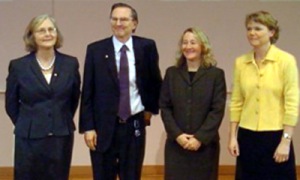UCSF's Elizabeth Blackburn Delivers Nobel Lecture
What does TTAGGG spell? If you’re human, it might spell long life.
That’s the sequence of DNA building blocks that keeps our cells ticking. The sequence bears repeating, and the more it repeats, the healthier we may be. In some populations loss of this DNA from key cells is associated with poor health and earlier death.
In Stockholm, Sweden, on Monday, UCSF’s Elizabeth Blackburn, PhD, along with two fellow scientists with whom she will share the 2009 Nobel Prize for Physiology or Medicine, described discoveries leading to October’s award announcement, including the first-ever identification of one of these key DNA sequences.
The Nobel laureates also discussed what their discoveries and ongoing research tells us about health, cancer and aging. The lectures are part of a weeklong series of events that will culminate with Thursday’s award ceremony.

Blackburn, along with Carol Greider, PhD, of Johns Hopkins University, and Jack Szostak, PhD, from Harvard Medical School, will be awarded the prize on Thursday for discoveries that have led to an understanding of how the cells of organisms ranging from protozoans to people are equipped to defend the integrity of their genetic blueprints through many generations of cell divisions.
Blackburn conducted experiments that enabled her to first describe bits of protective DNA – called telomeres—that cap chromosomes and prevent genes from being lost. This role is similar to that played by the wraps on the ends of shoelaces – called aglets – which keep our laces from unraveling.
A reserve of telomeres, like good aglets, can help keep life from tripping us up early, scientific studies now suggest. Telomeres tend to shorten with age. Blackburn and her recent collaborators have found that a high rate of telomere shortening in immune cells is associated with poor health outcomes in older heart disease patients, for instance. Telomere shortening now appears to play a role in triggering cancer. On the other hand, in more advanced cases of cancer, tumor cells are able to lengthen telomeres, a distinct survival advantage for rapidly growing tumors.
Before Blackburn’s discovery, it was not known how a cell could compensate for the fact that its DNA-replicating machinery does not function at the ends of its gene-bearing chromosomes. Researchers wondered why chromosomes didn’t simply shorten with each cycle of cell division, and lose vital genes over time.
Successful Collaboration
Blackburn has known Szostak and Greider for decades, and has worked with each of them to conduct experiments. But she first began studying telomeres as a postdoctoral fellow in the Yale laboratory of Joseph Gall, PhD. Blackburn completed and published telomere experiments on the single-cell protozoan Tetrahymena, an uncommon choice when it comes to studying problems in molecular biology.
Tetrahymena has many telomeres in comparison to the total amount of DNA it possesses, a factor that helped Blackburn to become the first to identify a telomeric sequence. In Tetrahymena, that turned out to be TTGGGG. Blackburn determined that this telomere sequence could be added to the chromosomes, although it was not yet clear how this was done.
Blackburn and Szostak, working from different scientific disciplines, decided to collaborate on an experiment viewed as having little chance for success. Tetrahymena and the budding yeast Saccharomyces cerrevisiea are from entirely different kingdoms of life, yet Blackburn and Szostak showed that yeast could use the Tetrahymena telomere sequence to stabilize long strands of DNA. This pointed to a fundamental and important process, one we now know is shared by many organisms, including humans.
Later, working as a graduate student in Blackburn’s lab, Greider was the first to track down a form of the enzyme, called telomerase, which can lengthen telomeres.
Today, Blackburn and Greider remain at the forefront of telomere research, while Szostak has left the telomere field.
Telomerase in Cancer
During her lecture, Blackburn described cancer-fighting strategies stemming from telomere research. The discovery that the telomerase enzyme very actively elongates telomeres in the cancerous cells of advanced tumors makes telomerase an attractive target within these tumor cells.
“Let’s use that fact,” Blackburn said. “Certainly one way would be to inhibit the enzyme, and there are efforts … in very early clinical trials.”
But Blackburn also described another, fast-acting mode of attack, which is to change the template within telomerase. The enzyme with the altered template adds mutated telomeres onto chromosomes. Normally specific proteins within cells attach to telomeres to help stabilize chromosome ends. But, as Blackburn also demonstrated much earlier in lesser organisms, the mutated telomere “repeats” added onto the chromosome ends are harmful to cells.
“The repeats are no longer the repeats that can bind the sequence-specific protective proteins,” she explained. The unprotected chromosome ends then “stick to each other like glue,” Blackburn said, wreaking havoc within the cancerous cell. With this approach, “you can kill cells quickly,” she added. Using animal models of cancer, Blackburn is working on ways to deliver this type of treatment to a targeted tumor.
Blackburn has branched beyond basic science to collaborate with clinical researchers and explore the role of telomeres in human stress, immune system health, heart disease, cancer and aging.
At a press conference, Blackburn noted how individuals infected with HIV in many cases appear to be aging prematurely, which suggests another area ripe for telomere studies.
“It’s not so much a cure for AIDS so much as understanding what’s happening,” Blackburn said. “Perhaps that will actually lead to insights into the normal process of aging, because of this inadvertent experiment that’s happened with people.”